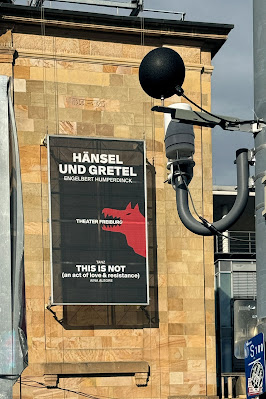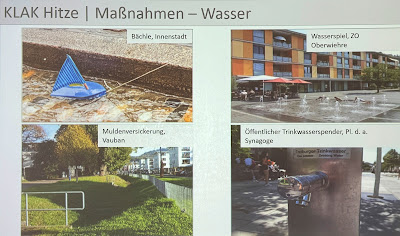
|
| Adaptation to the Climate in Freiburg |
The five gentlemen I first met there around 9 AM were not participants of the excursion, but as it turned out later, scientists who informed us about their work.
The institute has numerous measuring instruments to collect
climate-relevant data; however, due to its location between buildings,
the wind measurement is only relevant locally. Therefore, another
free-standing complete measuring station is located near the Freiburg
airport.
On our tour of Freiburg, we first visited a specific measuring station that investigates the influence of trees on the climate.
Until now, I had always assumed that deep-rooted trees tolerate climate
change and the decreasing precipitation better than shallow-rooted trees.
However, due to the previous dry summers, the soil has dried out to a depth
of 1.50 m, so shallow-rooted trees have an advantage with the bit of rain
that only wets the surface.
There is no ideal urban tree. Sycamore trees would still be the most suitable, but they emit the climate-damaging gas isopropanol. As a compromise, in the future, one has to select tree varieties that can best tolerate heat and water stress.
The next stop on our excursion was a measuring station of the University of Freiburg mounted high on a lamppost.

|
| Here is a measuring station downtown on a narrow street ... |

|
| ... and on the Square of the Old Synagogue with a view of the municipal theater. |
The scientists accompanying the tour presented their research results in a
lecture hall of the university.
There are many fields of action for climate adaptation in Freiburg. I will only mention the measures envisaged to combat excessive heat.
There are many fields of action for climate adaptation in Freiburg. I will only mention the measures envisaged to combat excessive heat.

|
| Click on the pictures to enlarge. |
Water serves several roles in climate adaptation. Freiburg's Bächle have a more psychological influence. Only extensive areas of water generate a cooling effect, and rainwater is collected in pits and then infiltrates the ground. With excessive heat, it's also important to provide sufficient drinking fountains distributed throughout the city.
In Freiburg, the number of tropical nights* has increased from a few per year to more than 20 in recent years. Here is the temperature distribution of a tropical night in Freiburg.
*During the night, the temperature does not fall below 20 °C between 6 PM and 6 AM
The city center, the industrial area in the north, a tree-lined villa district in Herdern, and the Rieselfeld quarter with its young stock of trees. As expected, the unshaded industrial center is the most hostile environment, the Platz der Alten Synagoge in the city is a hotspot, and a dense tree population has a marked cooling effect. Note that the other "red-colored" district on the overall map is Freiburg's industrial area in the south.
**
Supported by the measurement system, a well-being index for Freiburg was
simulated. This index considers not only the air temperature but
also parameters such as humidity and wind movements. Four areas of the city are highlighted for an air
temperature of 32 °C.
The city center, the industrial area in the north, a tree-lined villa district in Herdern, and the Rieselfeld quarter with its young stock of trees. As expected, the unshaded industrial center is the most hostile environment, the Platz der Alten Synagoge in the city is a hotspot, and a dense tree population has a marked cooling effect. Note that the other "red-colored" district on the overall map is Freiburg's industrial area in the south.
Red Baron's conclusion: take care of existing city trees and plant new
ones if possible.












No comments:
Post a Comment